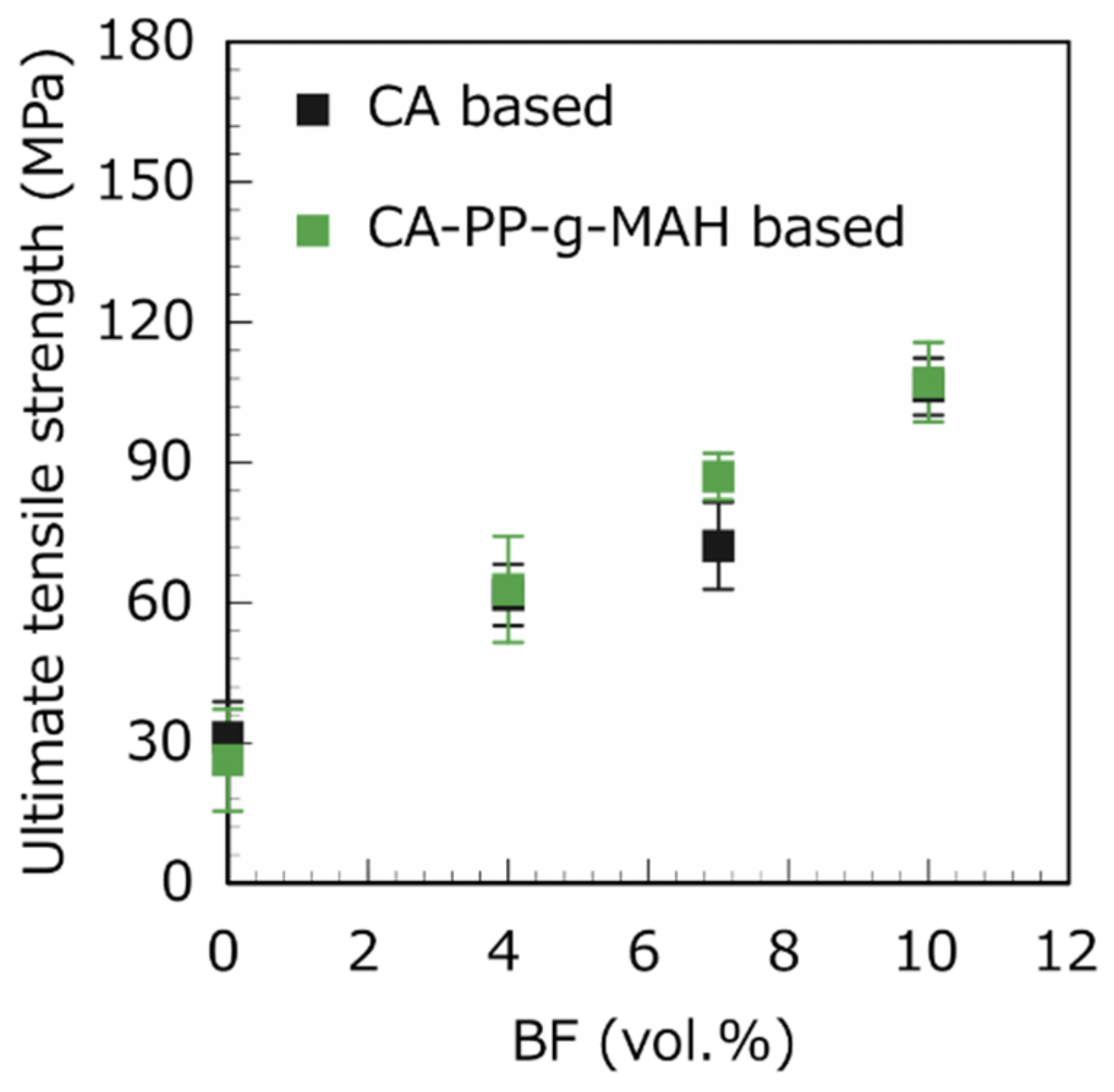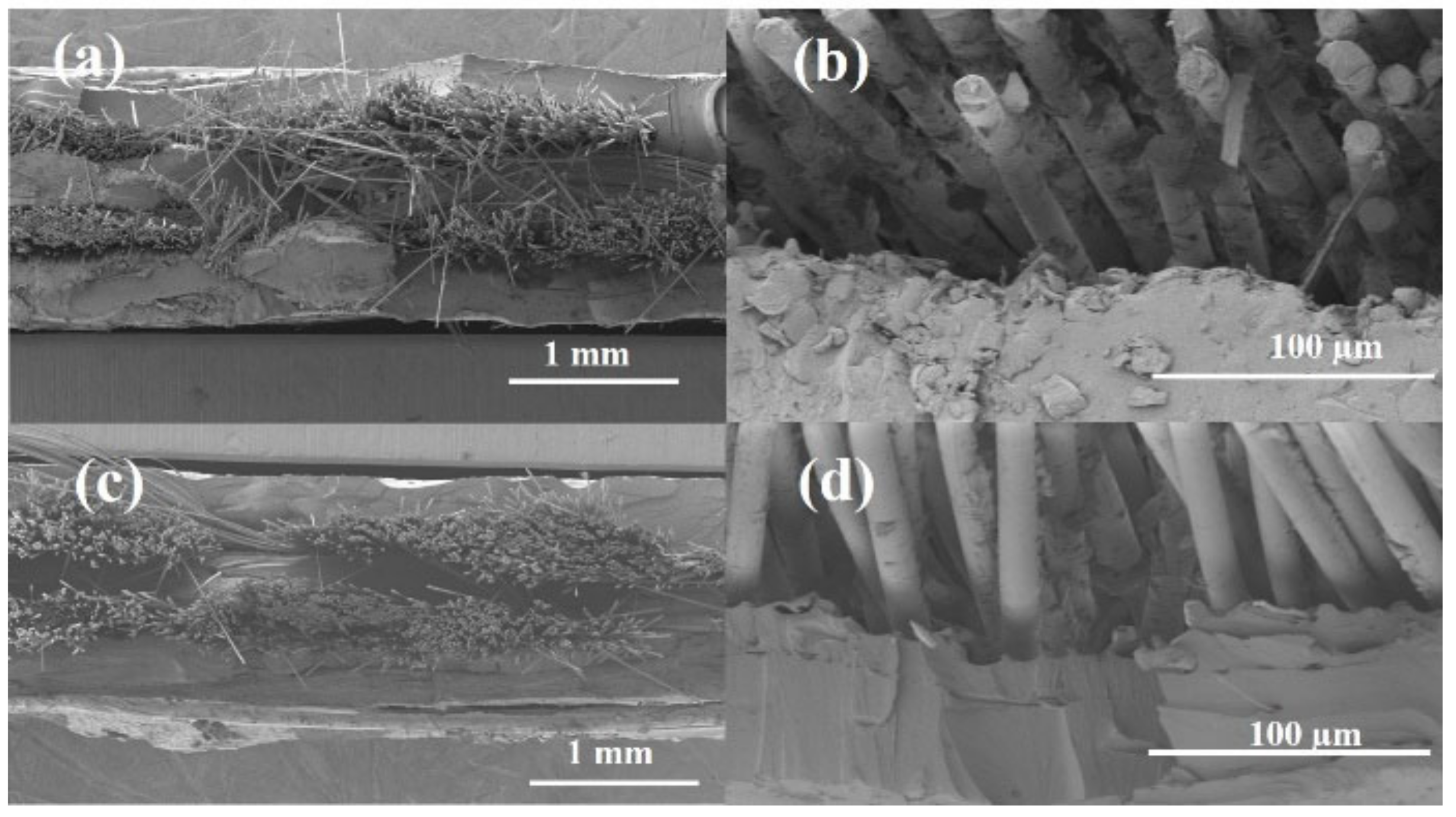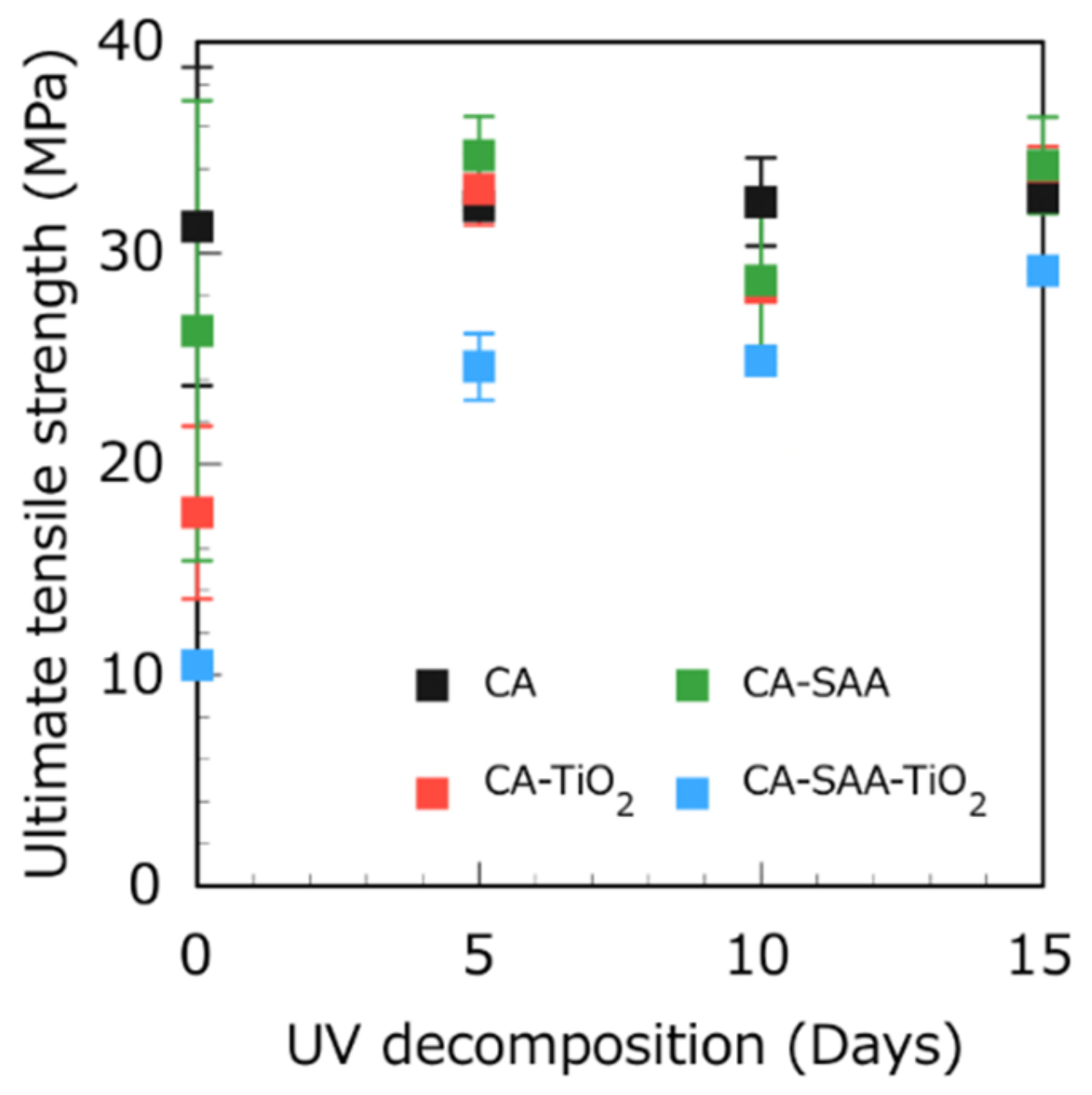Fabrication, Tensile Properties, and Photodecomposition of Basalt Fiber-Reinforced Cellulose Acetate Matrix Composites
Abstract
:1. Introduction
2. Experimental Procedure
2.1. Materials
2.2. Experimental Design
2.3. Fabrication of the CA Layer
2.4. Fabrication of the CA-SAA
2.5. Fabrication of the CA–SAA–TiO2 Layer
2.6. Fabrication of BF/CA Composites
2.7. UV Decomposition Test
2.8. Tensile Testing
3. Results and Discussion
3.1. Tensile Behavior of Unidirectional BF-Reinforced Composites
3.2. Effect of Surface Treatment on the Tensile Properties
3.3. SEM Observation of the Fracture Surfaces
3.4. Tensile Strength of CA Composites after UV Decomposition
4. Conclusions
Author Contributions
Funding
Institutional Review Board Statement
Informed Consent Statement
Data Availability Statement
Conflicts of Interest
References
- Shrivastava, R.; Singh, K.K. Interlaminar fracture toughness characterization of laminated composites: A review. Polym. Rev. 2020, 60, 542–593. [Google Scholar]
- Hohe, J.; Neubrand, A.; Fliegener, S.; Beckmann, C.; Schober, M.; Weiss, K.-P.; Appel, S. Performance of fiber reinforced materials under cryogenic conditions—A review. Compos. Part A 2021, 141, 106226. [Google Scholar] [CrossRef]
- Takeda, T.; Narita, F. Fracture behavior and crack sensing capability of bonded carbon fiber composite joints with carbon nanotube-based polymer adhesive layer under Mode I loading. Compos. Sci. Technol. 2017, 146, 26–33. [Google Scholar] [CrossRef]
- Katabira, K.; Kurita, H.; Yoshida, Y.; Narita, F. Fabrication and characterization of carbon fiber reinforced plastics containing magnetostrictive fe-co fibers with damage self-detection capability. Sensors 2019, 19, 4984. [Google Scholar]
- Meng, J.; Wang, Y.; Yang, H.; Wang, P.; Lei, Q.; Shi, H.; Lei, H.; Fang, D. Mechanical properties and internal microdefects evolution of carbon fiber reinforced polymer composites: Cryogenic temperature and thermocycling effects. Compos. Sci. Technol. 2020, 191, 108083. [Google Scholar] [CrossRef]
- Kaushik, V.; Bar, H.N.; Ghosh, A. Influence of extremely cold environmental conditions on interfacial fracture phenomenon of aerospace grade unidirectional composites. Thin Walled Struct. 2021, 161, 107431. [Google Scholar]
- Yamamoto, G.; Koizumi, K.; Nakamura, T.; Hirano, N.; Okabe, T. Tensile strength-controlling factors in unidirectional carbon fiber reinforced plastic composites. Compos. Part A 2021, 140, 106140. [Google Scholar]
- Faruk, O.; Bledzki, A.K.; Fink, H.-P.; Sain, M. Progress report on natural fiber reinforced composites. Macromol. Mater. Eng. 2014, 299, 9–26. [Google Scholar]
- Zheng, P.; Chen, N.; Mahfuzul Islam, S.M.; Ju, L.-K.; Liu, J.; Zhou, J.; Chen, L.; Zeng, H.; Lin, Q. Development of self-cross-linked soy adhesive by enzyme complex from aspergillus niger for production of all-biomass composite materials. ACS Sustain. Chem. Eng. 2019, 7, 3909–3916. [Google Scholar]
- Sahari, J.; Sapuan, S.M.; Zainudin, E.S.; Maleque, M.A. Mechanical and thermal properties of environmentally friendly composites derived from sugar palm tree. Mater. Des. 2013, 49, 285–289. [Google Scholar]
- Yusoff, R.B.; Takagi, H.; Nakagaito, A.N. Tensile and flexural properties of polylactic acid-based hybrid green composites reinforced by kenaf, bamboo and coir fibers. Ind. Crop. Prod. 2016, 94, 562–573. [Google Scholar] [CrossRef]
- Chen, P.-Y.; Lian, H.-Y.; Shih, Y.-F.; Chen-Wei, S.-M.; Jeng, R.-J. Preparation, characterization and crystallization kinetics of Kenaf fiber/multi-walled carbon nanotube/polylactic acid (PLA) green composites. Mater. Chem. Phys. 2017, 196, 249–255. [Google Scholar] [CrossRef]
- Sharma, S.; Majumdar, A.; Butola, B.S. Tailoring the biodegradability of polylactic acid (PLA) based films and ramie-PLA green composites by using selective additives. Int. J. Biol. Macromol. 2021, 181, 1092–1103. [Google Scholar] [CrossRef]
- Hu, C.; Bourbigot, S.; Delaunay, T.; Collinet, M.; Marcille, S.; Fontaine, G. Poly (isosorbide carbonate): A ‘green’ char forming agent in polybutylene succinate intumescent formulation. Compos. Part B 2020, 184, 107675. [Google Scholar] [CrossRef]
- Mochane, M.J.; Magagula, S.I.; Sefadi, J.S.; Mokhena, T.C. A review on green composites based on natural fiber-reinforced polybutylene succinate (PBS). Polymers 2021, 13, 1200. [Google Scholar] [CrossRef]
- Li, C.; Gao, S.; Yang, X.; Lin, C.S.K. Green and sustainable succinic acid production from crude glycerol by engineered Yarrowia lipolytica via agricultural residue based in situ fibrous bed bioreactor. Bioresour. Technol. 2018, 249, 612–619. [Google Scholar] [CrossRef]
- Jandura, P.; Riedl, B.; Kokta, B. Thermal degradation behavior of cellulose fibers partially esterified with some long chain organic acids. Polym. Degrad. Stab. 2000, 70, 387–394. [Google Scholar] [CrossRef]
- Zhou, H.; Lu, J.; Cheng, Y.; Lyu, Y.; Wang, H. Research progress on modification and application of cellulose acetate. Chem. Introd. For. Prod. 2020, 40, 1–8. [Google Scholar]
- Mohanty, A.K.; Wibowo, A.; Misra, M.; Drzal, L.T. Effect of process engineering on the performance of natural fiber reinforced cellulose acetate biocomposites. Compos. Part A 2004, 35, 363–370. [Google Scholar] [CrossRef]
- Swain, P.T.R.; Biswas, S. Influence of fiber surface treatments on physico-mechanical behaviour of jute/epoxy composites impregnated with aluminium oxide filler. J. Compos. Mater. 2017, 51, 3909–3922. [Google Scholar] [CrossRef]
- Karim, N.; Sarker, F.; Afroj, S.; Zhang, M.; Potluri, P.; Novoselov, K.S. Sustainable and multifunctional composites of graphene-based natural jute fibers. Adv. Sustain. Syst. 2021, 5, 2000228. [Google Scholar] [CrossRef]
- Baley, C.; Bourmaud, A.; Davies, P. Eighty years of composites reinforced by flax fibres: A historical review. Compos. Part A 2021, 144, 106333. [Google Scholar] [CrossRef]
- Maya, M.G.; George, S.C.; Jose, T.; Sreekala, M.S.; Thomas, S. Mechanical properties of short sisal fibre reinforced phenol formaldehyde eco-friendly composites. Polym. Renew. Resour. 2017, 8, 27–42. [Google Scholar] [CrossRef]
- Li, Q.; Li, Y.; Zhang, Z.; Zhang, Z.; Zhou, L. Quantitative investigations on multi-layer interface debonding behaviors for sisal fiber reinforced composites using acoustic emission and finite element method. Compos. Part B 2020, 196, 108128. [Google Scholar] [CrossRef]
- Ramos, N.; Miranda, M.S.; Franco, A.R.; Silva, S.S.; Azevedo, J.; Dias, I.R.; Reis, R.L.; Viegas, C.; Gomes, M.E. Toward spinning greener advanced silk fibers by feeding silkworms with nanomaterials. ACS Sustain. Chem. Eng. 2020, 8, 11872–11887. [Google Scholar] [CrossRef]
- Xie, Y.; Kurita, H.; Ishigami, R.; Narita, F. Assessing the flexural properties of epoxy composites with extremely low addition of cellulose nanofiber content. Appl. Sci. 2020, 10, 1159. [Google Scholar] [CrossRef] [Green Version]
- Narita, F.; Wang, Y.; Kurita, H.; Suzuki, M. Multi-scale analysis and testing of tensile behavior in polymers with randomly oriented and agglomerated cellulose nanofibers. Nanomaterials 2020, 10, 700. [Google Scholar] [CrossRef] [Green Version]
- Kurita, H.; Ishigami, R.; Wu, C.; Narita, F. Mechanical properties of mechanically-defibrated cellulose nanofiber reinforced epoxy resin matrix composites. J. Compos. Mater. 2021, 55, 455–464. [Google Scholar] [CrossRef]
- Wu, C.; Egawa, S.; Kanno, T.; Kurita, H.; Wang, Z.; Iida, E.; Narita, F. Nanocellulose reinforced silkworm silk fibers for application to biodegradable polymers. Mater. Des. 2021, 202, 109537. [Google Scholar] [CrossRef]
- Sim, J.; Park, C.; Moon, D.Y. Characteristics of basalt fiber as a strengthening material for concrete structures. Compos. Part B 2005, 36, 504–512. [Google Scholar]
- Jamshaid, H.; Mishra, R. A green material from rock: Basalt fiber—A review. J. Text. Inst. 2015, 107, 923–937. [Google Scholar] [CrossRef]
- Andrew, J.; Ramesh, C. Residual strength and damage characterization of unidirectional glass–basalt hybrid/epoxy CAI laminates. Arab. J. Sci. Eng. 2015, 40, 1695–1705. [Google Scholar] [CrossRef]
- Puls, J.; Wilson, S.A.; Hölter, D. Degradation of cellulose acetate-based materials: A review. J. Polym. Environ. 2011, 19, 152–165. [Google Scholar] [CrossRef] [Green Version]
- Potts, J.E.; Clendinning, R.A.; Ackart, W.B. An Investigation of the Biodegradability of Packaging Plastics; Environmental Protection Technology Series, EPA-R2-72-046, August 1972; Office of Research and Monitoring; U.S. Environmental Protection Agency: Washington, DC, USA, 1972; p. 20460. [Google Scholar]
- Northrop, D.M.; Rowe, W.F. Effect of the soil environment on the biodeterioration of man-made textiles. Biodeterior. Res. 1987, 1, 7–16. [Google Scholar]
- Buchanan, C.M.; Gardner, R.M.; Komarek, R.J. Aerobic biodegradation of cellulose acetate. J. Appl. Polym. Sci. 1993, 47, 1709–1719. [Google Scholar] [CrossRef]
- Hon, N.-S. Photodegradation of cellulose acetate fibers. J. Polym. Sci. Polym. Chem. Ed. 1977, 15, 725–744. [Google Scholar] [CrossRef]
- Jortner, J. Photochemistry of cellulose acetate. J. Appl. Polym. Sci. 1999, 7, 11657–11663. [Google Scholar]
- Hosono, K.; Kanazawa, A.; Mori, H. Photodegradation of cellulose acetate film in the presence of benzophenone as a photosensitizer. J. Appl. Polym. Sci. 2007, 105, 3235–3239. [Google Scholar] [CrossRef]
- Egerton, G.S.; Shah, K.M. The Effect of temperature on the photochemical degradation of textile materials: Part I: Degradation sensitized by titanium dioxide. Text. Res. J. 1968, 38, 130–135. [Google Scholar]
- Irick, G., Jr. Determination of the photocatalytic activities of titanium dioxides and other white pigments. J. Appl. Polym. Sci. 1972, 16, 2387–2395. [Google Scholar]
- Rabek, J.F. Role of metal compounds in the photodegradation of polymers. Polym. Photodegrad. 1995, 20, 353–365. [Google Scholar]
- Linsebigler, A.L.; Lu, G.; Yates, J.T., Jr. Photocatalysis on TiO2 surfaces: Principles, mechanisms, and selected results. Chem. Rev. 1995, 95, 735–758. [Google Scholar] [CrossRef]
- ASTM D3039/D3039M-17. Tensile Testing of Polymer Matrix Composites; ASTM International: West Conshohocken, PA, USA, 2017. [Google Scholar]
- Lovdal, A.L.V.; Laursen, L.L.; Andersen, T.L.; Madsen, B.; Mikkelsen, L.P. Influence of temperature on mechanical properties of jute/biopolymer composites. J. Appl. Polym. Sci. 2013, 128, 2038–2045. [Google Scholar] [CrossRef]
- Christian, S.J.; Billington, S.J. Moisture diffusion and its impact on uniaxial tensile response of biobased composites. Compos. Part B 2012, 43, 2303–2312. [Google Scholar] [CrossRef]
- Samper, M.D.; Petrucci, R.; Sánchez-Nacher, L.; Balart, R.; Kenny, J.M. New environmentally friendly composite laminates with epoxidized linseed oil (ELO) and slate fiber fabrics. Compos. Part B 2015, 71, 203–209. [Google Scholar] [CrossRef]











| Sample | UTS (MPa) | Young’s Modulus (GPa) | |
|---|---|---|---|
| CA | 35 | 1.9 | This study |
| Unidirectional BF/CA–SAA (11 vol.%) | 220 | 11 | This study |
| Plain-weave BF/CA–SAA (11 vol.%) | 110 | 7 | This study |
| Jute fibers/CA | 58 | 5.3 | [45] |
| Hemp fibers/CA | 58 | 6.0 | [46] |
| Slate fibers/Epoxidized linseed oil (ELO) matrix | 330 | 22 | [47] |
Publisher’s Note: MDPI stays neutral with regard to jurisdictional claims in published maps and institutional affiliations. |
© 2021 by the authors. Licensee MDPI, Basel, Switzerland. This article is an open access article distributed under the terms and conditions of the Creative Commons Attribution (CC BY) license (https://creativecommons.org/licenses/by/4.0/).
Share and Cite
Shen, Y.; Gallet-Pandellé, A.; Kurita, H.; Narita, F. Fabrication, Tensile Properties, and Photodecomposition of Basalt Fiber-Reinforced Cellulose Acetate Matrix Composites. Polymers 2021, 13, 3944. https://doi.org/10.3390/polym13223944
Shen Y, Gallet-Pandellé A, Kurita H, Narita F. Fabrication, Tensile Properties, and Photodecomposition of Basalt Fiber-Reinforced Cellulose Acetate Matrix Composites. Polymers. 2021; 13(22):3944. https://doi.org/10.3390/polym13223944
Chicago/Turabian StyleShen, Yuxi, Alia Gallet-Pandellé, Hiroki Kurita, and Fumio Narita. 2021. "Fabrication, Tensile Properties, and Photodecomposition of Basalt Fiber-Reinforced Cellulose Acetate Matrix Composites" Polymers 13, no. 22: 3944. https://doi.org/10.3390/polym13223944







